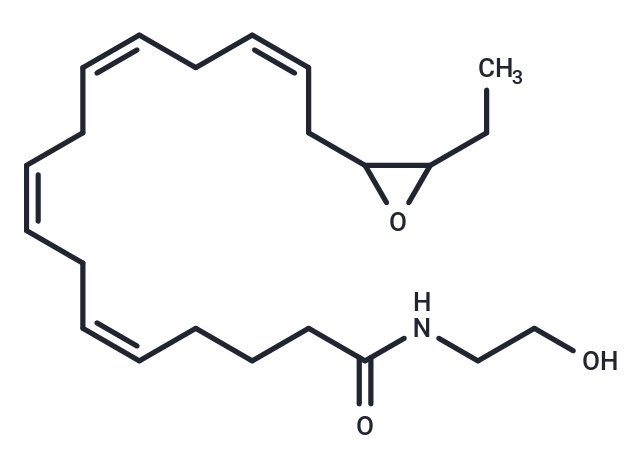- Remove All
 Your shopping cart is currently empty
Your shopping cart is currently empty
(±)17(18)-EpETE-Ethanolamide
(±)17(18)-EpETE-Ethanolamide, an ω-3 endocannabinoid epoxide, originates from eicosapentaenoic ethanolamide (EPEA) through cytochrome P450 (CYP) epoxygenases action and is decomposed by soluble epoxide hydrolase (sEH) and fatty acid amide hydrolase (FA, AH). Its endogenous synthesis occurs in LPS-stimulated and EPEA-supplemented BV-2 microglia cells, a process inhibited by the CYP inhibitor ketoconazole. This compound mitigates IL-6 and nitrite levels while enhancing IL-10 production following LPS exposure in BV-2 microglia. At a dose of 50 µM, it prevents platelet aggregation caused by arachidonic acid but not that triggered by ADP, collagen, or ristocetin. Additionally, it facilitates the dilation of constricted bovine coronary arteries (ED50= 1.1 µM) and blocks VEGF-driven tubulogenesis in human microvascular endothelial cells (HMVECs).

(±)17(18)-EpETE-Ethanolamide
| Pack Size | Price | Availability | Quantity |
|---|---|---|---|
| 10 mg | Inquiry | 8-10 weeks | |
| 50 mg | Inquiry | 8-10 weeks |
Product Introduction
| Description | (±)17(18)-EpETE-Ethanolamide, an ω-3 endocannabinoid epoxide, originates from eicosapentaenoic ethanolamide (EPEA) through cytochrome P450 (CYP) epoxygenases action and is decomposed by soluble epoxide hydrolase (sEH) and fatty acid amide hydrolase (FA, AH). Its endogenous synthesis occurs in LPS-stimulated and EPEA-supplemented BV-2 microglia cells, a process inhibited by the CYP inhibitor ketoconazole. This compound mitigates IL-6 and nitrite levels while enhancing IL-10 production following LPS exposure in BV-2 microglia. At a dose of 50 µM, it prevents platelet aggregation caused by arachidonic acid but not that triggered by ADP, collagen, or ristocetin. Additionally, it facilitates the dilation of constricted bovine coronary arteries (ED50= 1.1 µM) and blocks VEGF-driven tubulogenesis in human microvascular endothelial cells (HMVECs). |
| Alias | 17,18-epoxy-Eicosatetraenoic Acid Ethanolamide, 17,18-EEQ-EA, (±)17,18-EEQ-Ethanolamide, (±)17(18)-EpETE-EA |
| Molecular Weight | 361.52 |
| Formula | C22H35NO3 |
| Cas No. | 2123491-23-4 |
| Storage | Powder: -20°C for 3 years | In solvent: -80°C for 1 year | Shipping with blue ice. |
Sci Citations
Calculator
In Vivo Formulation Calculator (Clear solution)
Dose Conversion
Tech Support

Copyright © 2015-2025 TargetMol Chemicals Inc. All Rights Reserved.




